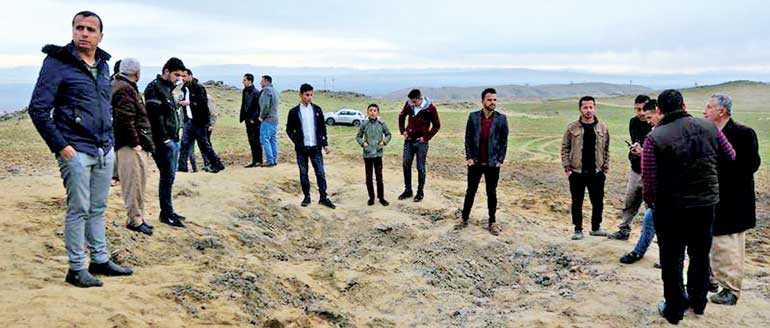Sunday Apr 20, 2025
Sunday Apr 20, 2025
Thursday, 9 January 2020 00:00 - - {{hitsCtrl.values.hits}}

Residents look at a crater caused by a missile launched by Iran on U.S.-led coalition forces on the outskirts of Duhok, Iraq, January 8, 2020 - Reuters
BAGHDAD/WASHINGTON/DUBAI (Reuters): Iranian forces fired missiles at military bases housing US troops in Iraq yesterday in retaliation for the US killing of an Iranian general, raising the stakes in its conflict with Washington amid concern of a wider war in the Middle East.
Iran’s Supreme Leader Ayatollah Ali Khamenei, addressing a gathering of Iranians chanting ‘Death to America’, said the attacks were a “slap on the face” of the United States and US troops should leave the region.
Tehran’s foreign minister said Iran took “proportionate measures” in self-defence and did not seek to escalate the confrontation. The next move appeared to lie with Washington.
US President Donald Trump, who ordered the drone strike that killed General Qassem Soleimani in Baghdad on Friday, gave an initial response on Twitter: “All is well!”.
Casualties and damage from the missile attacks were being assessed and Trump said he would make a statement on Wednesday. Trump, who was impeached last month and faces an election this year, at the weekend threatened to target 52 Iranian sites if Iran retaliated for Soleimani’s killing.
Casualty toll disputed
Iranian state television said Iran had fired 15 ballistic missiles from its territory at US targets in its neighbour Iraq. The bases targeted were al-Asad air base and another facility in Erbil, the Pentagon said.
One source said early indications were of no US casualties, while other US officials declined to comment.
Iranian television said 80 “American terrorists” had been killed and US helicopters and military equipment damaged. It provided no evidence of how it obtained that information.Germany, Denmark, Norway and Poland said none of their troops in Iraq were hurt. Britain, which also has personnel in Iraq, condemned the Iranian action. Iraq said its forces did not suffer casualties.
More than 5,000 US troops remain in Iraq along with the other foreign forces in a coalition that has trained and backed Iraqi forces against the threat of Islamic State militants.
“As we evaluate the situation and our response, we will take all necessary measures to protect and defend US personnel, partners, and allies in the region,” Pentagon spokesman Jonathan Hoffman said.
In Tehran, Khamenei said in a televised speech: “Military action like this is not sufficient. What is important is ending the corrupting presence of America in the region,” renewing Tehran’s long-standing demand for Washington to withdraw its forces. Iranian Foreign Minister Mohammad Javad Zarif said the strikes “concluded” Tehran’s response to the killing of Soleimani, who had been responsible for building up Iran’s network of proxy armies across the Middle East. He was buried in his hometown Kerman on Monday after days of national mourning.
“We do not seek escalation or war, but will defend ourselves against any aggression,” he wrote on Twitter.
Iranian television reported an official in the supreme leader’s office as saying the missile attacks were the “weakest” of several retaliation scenarios. It quoted another source saying Iran had lined up 100 other potential targets. The state media also showed footage of what it said were the missiles being fired into the night sky. In the background, voices shouted “God is greatest”. It also showed what it said were images of the blasts where they struck. It was not possible to verify the images’ authenticity.
Tehran’s defence minister said the missiles were Iranian-built.
If the U.S. military was spared casualties and Iran takes no further measures to retaliate for Soleimani’s killing, there might be an opportunity for Washington and Tehran to seek a way out of their increasingly violent confrontation.
Analysts have said that despite its strident rhetoric, Iran will want to avoid any conventional military conflict with superior U.S. forces. In the past, they say it has focussed on asymmetric strikes, such as sabotage or other military action via proxies.
U.S. officials said Soleimani was killed because of intelligence indicating forces under his command planned attacks on U.S. targets in the region. They have not provided evidence.
Before Soleimani was buried his body was taken on a tour of cities in Iraq and Iran, drawing huge crowds. A stampede at his funeral on Tuesday killed at least 56 people. An hour after the Iranian missile attack, state television showed footage of the burial, where hundreds of people started chanting “God is greatest” when the strikes were announced over loudspeakers.
Discover Kapruka, the leading online shopping platform in Sri Lanka, where you can conveniently send Gifts and Flowers to your loved ones for any event including Valentine ’s Day. Explore a wide range of popular Shopping Categories on Kapruka, including Toys, Groceries, Electronics, Birthday Cakes, Fruits, Chocolates, Flower Bouquets, Clothing, Watches, Lingerie, Gift Sets and Jewellery. Also if you’re interested in selling with Kapruka, Partner Central by Kapruka is the best solution to start with. Moreover, through Kapruka Global Shop, you can also enjoy the convenience of purchasing products from renowned platforms like Amazon and eBay and have them delivered to Sri Lanka.
Discover Kapruka, the leading online shopping platform in Sri Lanka, where you can conveniently send Gifts and Flowers to your loved ones for any event including Valentine ’s Day. Explore a wide range of popular Shopping Categories on Kapruka, including Toys, Groceries, Electronics, Birthday Cakes, Fruits, Chocolates, Flower Bouquets, Clothing, Watches, Lingerie, Gift Sets and Jewellery. Also if you’re interested in selling with Kapruka, Partner Central by Kapruka is the best solution to start with. Moreover, through Kapruka Global Shop, you can also enjoy the convenience of purchasing products from renowned platforms like Amazon and eBay and have them delivered to Sri Lanka.